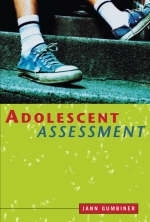
Adolescent Assessment
John Wiley & Sons Inc (Verlag)
978-0-471-41981-5 (ISBN)
- Titel ist leider vergriffen;
keine Neuauflage - Artikel merken
Adolescent Assessment also includes a summary of the following popular assessment instruments for teens: * Achenbach System of Empirically Based Assessment (ASEBA) * Beck Depression Inventory, Second Edition (BDI(r)-II) * Conner's Rating Scales, Revised (CRS-R) * The Goodenough-Harris Drawing Test * MacAndrew Alcoholism Scale, Revised (MAC-R) * Millon Adolescent Clinical Inventory (MACI(t)) * Minnesota Multiphasic Personality Inventory-Adolescent (MMPI-A(t)) * Rotter Incomplete Sentences Blank (RISB(r)) * The Strong Interest Inventory (SII(r)) * The Wechsler Intelligence Scale for Children, Third Edition (WISC-III(r)) * The Wide Range Achievement Test-3 (WRAT3(t)) * The Woodcock-Johnson III Tests of Achievement (WJ III(r) ACH) * The Woodcock-Johnson III Tests of Cognitive Abilities (WJ III(r) COG)Five helpful appendices include a list of the most commonly used assessment tests for adolescents and when to use them, a description of problem-based assessment, case studies and suggested test batteries, test-ordering information, and the American Psychological Association's revised Ethical principles of Psychologists and Code of conduct, section 9.
Adolescent Assessment is an essential reference for school and child psychologists, school counselors, and school social workers.
JANN GUMBINER, PhD, is a licensed psychologist and clinical professor at the University of California, Irvine College of Medicine, and served on the faculty at Chapman University, where she specialized in adolescent and child development. She has published extensively on the subject of testing and adolescents, focusing on the MMPI-A(t).
Preface. Chapter 1: The Assessment and Testing Process. Assessment as Science. Purposes of Assessment. Guidelines for Sound Assessments. Steps in the Assessment Process. Rapport. Referral. Collect Background Information and Data. Formulate Testable Hypotheses. Rationale. Conduct Testing. Synthesis, Revision, and Feedback. Advantages of Psychological Tests. Selection of Tests for This Book. Ethics and Test User Qualifications. Chapter 2: Adolescent Development. History. The Study of Adolescence. Biological Development. Growth Spurt. Sexual Maturation. Early and Late Maturers. Body Image. Cognitive and Moral Development. Cognitive Development. Social Cognition. Moral Development. Intelligence. IQ. General g or Multiple Intellgences? Intelligence and Age. Mental Retardation and Giftedness. Psychological Development. Temperament. Coping Styles. Developmental Tasks. Identity. Social Development. Parents. Friends. Conclusion. Chapter 3: Adolescent Mental Health Problems and Diagnoses. DSM-IV-TR and Diagnosing Adolescents. Prevalence of Mental Disorders. Gender, Age, and Ethnicity. Anxiety Disorders. Etiology. Symptoms. Suggested Psychological Tests. Diagnostic Suggestions. Conduct Disorder and Delinquency. Etiology. Symptoms. Suggested Psychological Tests. Diagnostic Suggestions. Depression. Etiology. Symptoms. Suggested Psychological Tests. Diagnostic Suggestions. Eating Disorders. Etiology. Symptoms. Suggested Psychological Tests. Diagnostic Suggestions. Oppositional Defiant Disorder. Etiology. Symptoms. Suggested Psychological Tests. Diagnostic Suggestions. Sexual Abuse. Etiology. Symptoms of PTSD. Suggested Psychological Tests. Diagnostic Suggestions. Substance-Related Disorders. Etiology. Who Uses and Why. Alcohol. Marijuana. Ecstasy and Other Drugs. Suggested Psychological Tests. Diagnostic Suggestions. Suicide Risk. Suicide Themes. Suicide Risk Factors. Suggested Psychological Tests. Diagnostic Suggestions. Conclusion. Chapter 4: Diversity. Culture. Test Fairness. Language. Acculturation. Gender. Age. Learning Disabilities. History of Learning Disabilities. Information Processing. Development of Learning Disabilities. Types of Learning Disabilities. Assessing a Learning Disability. Physical Disabilities. History of Physical Disabilities. Testing Accommodations. Hearing Impairment. Visual Impairment. Other Impairments. Chapter 5: Psychometric Review. Correlation Coefficient. Standardization and Norms. Norms. Representativeness. Size. The Normal Probability Curve, Standard Deviations, and Percentiles. Reliability. Standard Error of Measurement. Validity. Face Validity. Content Validity. Construct Validity. Predictive Validity. Short Forms. Chapter 6: Test Reviews. Achenbach System of Empirically Based Assessment (ASEBA). Purpose, Use, and Brief Description. Administration, Scoring, and Interpretation. Ethnic and Gender Differences. Psychometric Properties. Summary. Beck Depression Inventory-Second Edition (BDI-II). Purpose, Use, and Brief Description. Administration, Scoring, and Interpretation. Ethnic and Gender Differences. Psychometric Properties. Summary. Conners' Rating Scales-Revised (CRS-R). Purpose, Use, and Brief Description. Administration, Scoring, and Interpretation. Ethnic, Gender, and Age Differences. Psychometric Properties. Summary. Goodenough-Harris Drawing Test. Purpose, Use, and Brief Description. Administration, Scoring, and Interpretation. Ethnic and Gender Differences. Psychometric Properties. Summary. MacAndrew Alcoholism Scale-Revised (MAC-R). Purpose, Use, and Brief Description. Administration, Scoring, and Interpretation. Ethnic and Gender Differences. Psychometric Properties. Summary. Millon Adolescent Clinical Inventory (MACI). Purpose, Use, and Brief Description. Administration, Scoring, and Interpretation. Four Step Interpretive Model. Ethnic, Gender, and Socioeconomic Differences. Psychometric Properties. Summary. Minnesota Multiphasic Personality Inventory-Adolescent (MMPI-A). Purpose, Use, and Brief Description. Administration, Scoring, and Interpretation. Ethnic and Gender Differences. Psychometric Properties. Summary. Rotter Incomplete Sentences Blank (RISB). Purpose, Use, and Brief Description. Administration, Scoring, and Interpretation. Psychometric Properties. Summary. The Strong Interest Inventory (SII). Purpose, Use, and Brief Description. Administration, Scoring, and Interpretation. Ethnic and Gender Differences. Psychometric Properties. Summary. The Wechsler Intelligence Scale for Children-Third Edition (WISC-III). Purpose, Use, and Brief Description. Administration, Scoring, and Interpretation. Psychometric Properties. Summary. The Wide Range Achievement Test-3 (WRAT3). Purpose, Use, and Brief Description. Administration, Scoring, and Interpretation. Psychometric Properties. Summary. Woodcock-Johnson III Tests of Achievement (WJ III ACH). Purpose, Use, and Brief Description. Administration, Scoring, and Interpretation. Psychometric Properties. Woodock-Johnson III Tests of Cognitive Abilities (WJ III COG). Purpose, Use, and Brief Description. Administration, Scoring, and Interpretation. Psychometric Properties. Summary. Appendix A Common Adolescent Tests and Their Best Uses. Appendix B Diagnostic Issues and Suggested Tests. Appendix C Case Studies, Suggested Test Batteries, and Rationales. Appendix D APA Ethical Principles of Psychologists and Code of Conduct (2002), Standard 9-Assessment. Appendix E Test Ordering Information. References. Author Index. Subject Index.
| Erscheint lt. Verlag | 15.8.2003 |
|---|---|
| Zusatzinfo | Illustrations |
| Verlagsort | New York |
| Sprache | englisch |
| Maße | 182 x 259 mm |
| Gewicht | 708 g |
| Themenwelt | Geisteswissenschaften ► Psychologie ► Entwicklungspsychologie |
| Geisteswissenschaften ► Psychologie ► Test in der Psychologie | |
| Sozialwissenschaften ► Soziologie | |
| ISBN-10 | 0-471-41981-8 / 0471419818 |
| ISBN-13 | 978-0-471-41981-5 / 9780471419815 |
| Zustand | Neuware |
| Haben Sie eine Frage zum Produkt? |
aus dem Bereich


